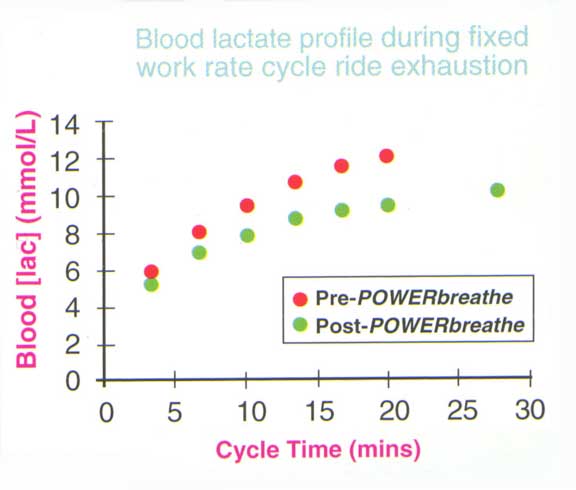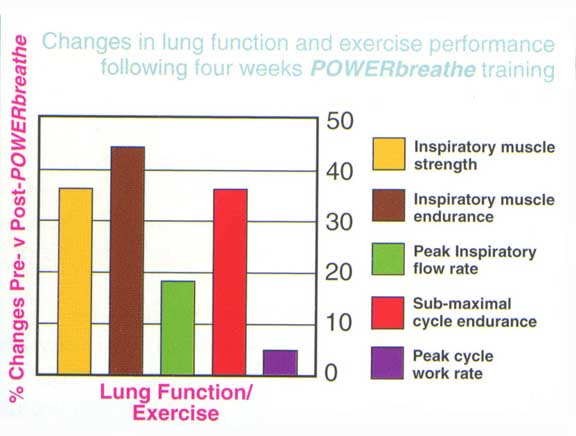ADDITIONAL
INFORMATION ON THE
POWERbreathe®
The following is a sample of just some of the supporting Scientific Research information. This research, involving continuous studies, over a 10 year period, summarizes the remarkable benefits that are derived from the use of the POWERbreathe®.
Years Of Research has shown that the inspiratory muscles have such a huge task to perform that they can “steal” blood from our exercising limbs to supplement their work (Harms, C. 2000 ‘Effect of skeletal muscle demand on cardiovascular function’ Med.Sci.Sports Exerc. 32 (1): 94-99). The effect of this is to limit the performance of those limb muscles making exercise feel harder and impairing performance. New research has now shown that specific inspiratory muscle training (IMT) improves the efficiency of the inspiratory muscles (Sharpe & McConnell, 1998), with the results being that performance in laboratory controlled trials is improved by almost 30% (Caine & McConnell, 1998).
Athletic Endurance and Performance studies have shown that time trial performance improves in elite rowers (Voliantis et al., 2001a) and cyclists (Romer et al., 2001a) by as much as 4.6%! That slashes almost 3 minutes off a 40km cycling time trial and gives a winning margin of more than 60m in a 2000m rowing race. In athletes, POWERbreathe® training has elicited improvements in strength by 31.2% and endurance by 27.8% (Caine &McConnell)
New studies have shown that specific inspiratory muscle training improves efficiency of the inspiratory muscles (Sharpe & McConnell, 1998). By overloading the inspiratory muscles using tried and proven principles of resistance training, their strength, power and endurance improves (Romer et al., 2001b) Within a few days inspiratory muscles will feel stronger, within 3 weeks the user will feel less breathless and within 4 weeks performance will improve (Caine & McConnell, 1998; Volianitis et al., 2001a; Romer et al., 2001).
Research
has also shown that a standard warm-up fails to prepare the inspiratory
muscles for the rigors of exercise (Volianitis et al., 1999). Laboratory
trials show that a POWERbreathe® warm up significantly improves rowing
performance and reduces breathlessness in competitive rowers (Volianitis
et al., 2001b). POWERbreathe® has undergone rigorous and systematic
testing to identify the most effective training regimen (Caine &
McConnell, 1998). The ’30 breaths twice a day’ training regimen is
specifically designed to provide the optimum conditions to improve your
breathing power (Romer et al., 2001b).
Respiratory Disorder Studies found that POWERbreathe® is also great for asthmatics, emphysema sufferers or anyone else who suffers from respiratory problems. Numerous research trials have already been conducted, examining breathlessness, respiratory muscle fatigue and sport performance in many groups of people. As a result, many benefits of POWERbreathe® training have been identified, in terms of wellbeing, general fitness and sports performance. As the user inhales against the load of the POWERbreathe®, the inspiratory muscles are made to work harder. This training stimulus induces improvements in the force generating capacity and metabolic efficiency of the inspiratory muscles (Sharpe et al., unpublished observations). Training is accomplished with as little as 5 minutes training per day and patients perceive benefits within 3 weeks of starting the training (McConnell et al., 1998).
In random, controlled trials, on mild/moderate asthmatics, POWERbreathe® increased inspiratory muscle strength by a mean of 11% in just 3 weeks (McConnell et al., 1998). Inspiratory muscle training has been shown to relieve the symptoms of asthma by improving lung function, resulting in reduction of medication and a decline in hospitalizations. In additional random, controlled trials, POWERbreathe® has been shown to generate improvements in inspiratory muscle strength of 55% and endurance of 86% in patients with COPD (Newell et al., 1998)
Dyspnoea is a common feature of many disorders. Its source may be respiratory, cardiovascular, neuromusclar or even psychological. Inspiratory muscle weakness has been identified as a contributory factor in the perception of Dyspnoea (Killian, 1998). Training of the inspiratory muscles has been demonstrated to increase their strength, resistance to fatigue and, most importantly, to reduce exertional Dyspnoea. (Lisboa, 1994; Copestake & McConnell, 1995; Lisboa, 1997; McConnell et al., 1998). Reduction in exertional Dyspnoea has been demonstrated in healthy elderly people (Copestake & McConnell, 1995), asthmatics (McConnell et al., 1998) and patients with COPD (Lisboa et al., 1994, 1997).
Corticosteriods are used to treat a large number of disease conditions, but significant reductions in inspiratory muscle strength have been documented after an acute treatment of oral Corticosteroids. Research has shown that a concomitant period of inspiratory muscle training can eliminate the fall in inspiratory muscle strength, therefore maintaining lung function during Corticosteroid use (Weiner et al., 1996).
Inspiratory muscle training has improved inspiratory muscle function in conditions such as Cystic fibrosis (Sawyer et al., 1993), Neuromuscular diseases including MS (Foglio et al., 1994), Duchenne muscular dystrophy (Wanke et al., 1994), Spinal cord injury (Huldtgren et al., 1980), Chronic heart failure (Cahalin et al., 1997), Mancini et al., 1995) and Heart lung transplant patients (Ambrosino et al., 1996).
POWERbreathe® was researched and developed by SPORTS SCIENTISTS at Birmingham University UK.

